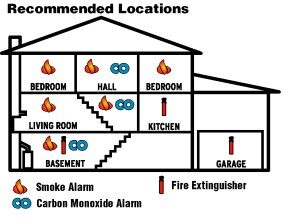In addition to the General Public Frequently Asked Questions (FAQ) shown below, please scroll down to view our Careers FAQ and our Smoke & Carbon Monoxide Alarm FAQ. Thank you!
Hiring Process
*Note: Applicant must pass each step to continue through the process.
The minimum requirements are:
The required certifications for Recruits are:
1. Valid Basic, Intermediate, or Advanced Firefighter Certification from the Texas Commission on Fire Protection, and
2. Valid EMT Basic, Advanced, or Paramedic Certificate from either the Texas Department of State Health Services or National Registry
No certifications are required for the Fire Cadet position.
Required documents to be submitted with the Recruit application include:
Required documents to be submitted with the Cadet application include:
The steps for the application process are:
There are three sections for the written examination:
The minimum score is seventy (70) for each section.
You have three (3) opportunities to pass CPAT. There are two (2) CPAT practice sessions and one (1) test.
The panel oral board interview is the next step after the written test and pre-hire fitness assessment. This is an interview with three to four officers of the District. The interview usually focuses on interpersonal and verbal communication skills, analytical ability, and the motivation to be a firefighter. This is a professional interview and should be treated as such.
Yes, applications can be mailed to:
Travis County ESD No. 2
Pflugerville Fire Department
Attn: Human Resources
203. E. Pecan Street
Pflugerville, Texas 78660.
Yes, your application packet can be delivered Monday through Friday from 9:00 a.m. to 4:00 p.m. to the Administration Building at 201 East Pecan Street, Pflugerville, TX 78660.
Yes, your application packet must include all required materials as listed under the Career FAQ question number 3.
To find out if your certification will transfer please contact the Texas Commission on Fire Protection Customer Support at (512) 936-3828 or (512) 936-3826.
For TCFP certification click here or on weblink, https://www.tcfp.texas.gov/services/search-individual-department, and enter your last name.
For EMT certification from the Texas Department of State Health Services click here or on weblink,https://vo.ras.dshs.state.tx.us/datamart/login.do and Go to License Search, Select Search by Name for a Specified License Type and Select EMT Personnel and enter your name.
For EMT certification from the National Registry click here or on weblink, https://www.nremt.org/verify-credentials, and select State, Enter Name, M.I., Last Name and Submit.
The Candidate Physical Ability Test© (CPAT) is a standardized (pass/fail) physical fitness test conducted to determine an applicant’s ability to physically perform duties commonly required of a firefighter, which consists of eight occupational related events. All applicants must pass the CPAT with Travis County ESD No. 2; we will only accept CPAT certificates issued by Travis County ESD No. 2. Previous CPAT certification issued elsewhere, regardless of date, will not be accepted.
Thank you for caring about neighborhood safety! Each year, we receive numerous requests for our fire trucks to be part of neighborhood activities on National Night Out, which in Texas is celebrated on the first Tuesday evening in October. The year, National Night Out will be celebrated on Tuesday, October 7, 2025.
You can submit a request for us to visit your event by clicking the button below and filling out our form. The deadline to submit a request is October 1, 2025.
Yes, we would love to have your group or family visit one of our fire stations! Station Tours should be booked at least two weeks in advance. We encourage our firefighters to always start all tours with safety education. Please keep in mind that the firefighters will be on-duty, which can delay their return to the station after an emergency call or take them away to an emergency during your visit. Tours last roughly 30 minutes (but can be shortened or lengthened according to the interests of the group). To request a tour, click the blue button below.
While we do not have birthday parties at our fire stations, we are happy to give the birthday boy/girl and guests an educational tour of the fire station on or around the special day.
First, a history lesson. Remember, the fire service has been established for hundreds of years when compared to the modern healthcare system. In our local community, the Fire Department pre-dates EMS (the volunteer FD was one of the first community services established in the Pflugerville area). In the olden days, everything was highly flammable, and fire was the primary heat and light source. Fires were quite common, and Pflugervilles’s history has its share of notorious and destructive fires. A large portion of downtown burned down, and before that a large hotel burned down. In response to these and other fire incidents, early community leaders organized local resources and developed what would become known today at Travis County ESD No.2, the Pflugerville Fire Department.
But times have certainly changed. While structure fires still occur on a regular basis in the growing community, the size and intensity of these fires is able to be controlled by the District having multiple fire stations and personnel who can respond to them in a timely manner and control them quickly. What used to burn a block down, can be contained to a kitchen with quick notification. Additionally, establishment of a local fire code has made commercial buildings much safer and less prone to fires when compared to the past. Just like the FD was born out of an early community need, we now respond to a new essential need- medical services calls. In fact, approximately 70% of the 911 calls we receive are for medical services. Because of this, all firefighters in the District are EMTs (Emergency Medical Technicians), many of our firefighters are paramedics. This all led to the District offering full emergency medical services including ambulance transport.
Performing basic and advanced life saving work takes multiple hands, or highly trained personnel to deliver those skills. Some of these skills include advanced airway procedures, establishing IVs (intravenous) to deliver medications, as well as operating sophisticated defibrillator/monitoring equipment to help shock a patient’s heart if they are in cardiac arrest. Performing effective chest compressions in the event of a cardiac arrest patient requires a high level of fitness and several responders to rotate in and out to maintain the consistent manual pumping of a patient’s chest to mirror its normal function. Try pushing down on a firm cushion yourself at a pace of 100 compressions per minute for 5 minutes (if you are fit enough to exercise). You will see it’s quite a workout. Now imagine doing this for 20-30 minutes. Additionally, many of our patients are so sick they are unable to move on their own. Often, we have to physically pick and move these patients onto the stretcher. All of this takes the work of several firefighter emt/paramedics. If you have been treated in an emergency room for a serious injury or medical condition, you were cared for by several techs, nurses, physician’s assistants, and physicians. When you call 911 fire and EMS personnel are bringing many of those same skills and procedures to your living room.
Lastly, many times responders face unique challenges on medical calls. For example, think about the car crash that needs victims extricated using (the Jaws of Life) tools. Or, a medical call in a home that has carbon monoxide poisoning and requires respirator protection to enter. Think about patients who are incapacitated and can not open a locked door into the building. In these situations, firefighters provide an additional necessary skill set. And if the firefighters are not necessary, they are cleared quickly so they are available to respond to another medical call or fire.
So while it may seem strange to have a fire truck pull up outside your home when you’ve called 911 because of an emergency medical situation, there are many reasons to be thankful firefighters have arrived to begin quickly helping you or your loved one. The District exists solely to help you in your time of need, your worst time of need. That’s why we send you the best resources to increase the chances of a successful outcome.
Yes! In 2017, we began operating our own ambulances out of each of our fire stations utilizing our own paramedics. We currently have four ambulances in service, plus reserve units. In addition, some of our fire trucks are specially equipped to provide Advance Life Support at the incident scene.
Pflugerville residents with concerns about animals stuck in trees are best served by calling the City of Pflugerville Animal Control for assistance at (512) 990-PETS. The City of Pflugerville Animal Control can also assist with snake issues. However for removal of bees or wasps, the City advises that “an exterminator or bee keeper will need to be called. Service providers can be found online or in a phone directory.”
Residents of unincorporated Travis County may call County Animal Control at (512) 974-2000.
* * If an animal, snake, or insect has caused serious injury, please call 9-1-1 for emergency medical care. * *
Travis County occasionally issues a burn ban. When a burn ban is in effect, “open burning” is not allowed, meaning outdoor, open-flame burning that is not fully enclosed. The Travis County Fire Marshal has a webpage which further explains county burn bans. The burn ban may be in effect for a few days or a few weeks. You can find out the current status—either ON or OFF—by looking at the Burn Ban button on the top of our website home page, which is updated daily Monday through Friday.
However, even when the county burn ban is off, you must still obtain a permit from us for outdoor burns! Click here for permit application information.
NOTE: A burn ban is not the same as a fireworks ban. These bans are issued separately.
A few local organizations, such as Safe Kids Austin and Dell Children’s Medical Center, have certified technicians on staff to install and check car/booster seats by appointment on certain days of the month. Click here for their contact information and the schedule.
A great source of information is the National Highway Traffic Safety Administration (NHTSA) car/booster seat webpage.
To email the State of Texas for more information about car/booster seats, write to: [email protected]
We do not currently provide CPR or first aid classes for official certification. For more information on this life-saving skill, please visit our Cardiac Arrest & CPR webpage.
You are welcome to donate to the Travis County Emergency Services District No. 2 or the FirstIn Pfloundation. Donations can be mailed to the District’s Administration address or delivered to the front desk. The FirstIn Pfoundation is committed to supporting the District by promoting safety and supporting response capability to the community. Thank you for your support!
An Emergency Services District (ESD) is a local government agency created by a public vote to provide fire protection and/or emergency medical services in a specific area. The governing statute for an ESD is Chapter 775 of the Texas Health & Safety Code, making an ESD a political subdivision of the State of Texas.
Travis County Emergency Services District 2 is headquartered in Pflugerville, but we are not part of city/municipal government. We are governed by a Board of Emergency Commissioners who are volunteers appointed by the Travis County Commissioners Court.
As an ESD, we are funded primarily by property taxes, which by law are capped for all ESDs at $0.10 per $100 of home value, plus a sales tax supplement. Our service area covers approximately 100 square miles, including the City of Pflugerville at the center, Wells Branch to the west, and unincorporated Travis County to the east and south. Click here to see our service area map.
We utilize the 2021 International Fire Code (IFC) for inspections and plan reviews concerning occupancies both in the city limits of Pflugerville and within unincorporated Travis County. Additional local amendments apply; see Fire Code for more information.
Each of our fire stations has a sign out front that we update daily to inform you of the current Fire Danger Rating. You can also find the current Fire Danger Rating at the top of the home page of our website.
The National Fire Danger Rating System was designed to let firefighters and the general public know how easily a fire could start outdoors that day. There are five ratings: Extreme, Very High, High, Moderate, and Low. The ratings take into account factors such as: temperature, moisture, wind, topography, and types of vegetation. Finding out the current rating helps you know when to postpone any outdoor burning and when to be especially careful with grills, outdoor fireplaces, campfires and bonfires, equipment that may produce sparks, disposing of cigarettes/matches, and taking your RV or truck into grassy areas.
More information on the ratings is available on our Fire Danger Ratings webpage.
The acronym for remembering how to use a Fire Extinguisher is P-A-S-S:
For more information on extinguishers, including a brief video tutorial, please visit our Fire Extinguisher webpage. Regarding the safe disposal of used fire extinguishers, we encourage residents to follow the manufacturer’s instructions.
Fire Code requires that at least 3 feet of clearance in all directions of a fire hydrant be maintained at all times; landscaping must be cut back accordingly.
In addition, Texas Transportation Code prohibits drivers from parking a vehicle – whether occupied or unoccupied – within 15 feet of a fire hydrant. (Also, Texas Law prohibits drivers from parking within 20 feet of the driveway entrance to a fire station and on the side of a street opposite a marked entrance to a fire station within 75 feet of that entrance.)
Local law enforcement officers enforce these laws:
Texas Occupations Code prohibits parking in or obstructing a marked fire lane. Local police enforce this law in the City of Pflugerville; you can report concerns any time of day to their non-emergency number at (512) 990-6700.
We welcome the opportunity to educate residents of all ages about fire and life safety. Requests to visit schools or events that are open to the general public should be submitted at least two to three weeks in advance. If approved, visits are generally limited to one hour and are always contingent on firefighters not being pulled away for emergency calls. Your patience and understanding are appreciated! For more information, call (512) 251-2801 and ask for Community Outreach.
Please note that we cannot consider requests to send fire trucks to private parties.
The safest legal way to enjoy fireworks is to attend a professional fireworks show, such as the Pfirecracker Pfestival in Pflugerville or the 4th Fest in Wells Branch.
For personal fireworks, the answer depends on where you are located! Within the City of Pflugerville boundaries, all fireworks (including sparklers) are ILLEGAL throughout the year. Local police enforce this law; you can report concerns any time of day to their non-emergency number at (512) 990-6700.
In unincorporated Travis County, fireworks are generally are legal but THERE ARE SEVERAL LIMITATIONS, as listed below. Call the the Sheriff’s dispatch number (512) 974-0845 then press OPTION 3 for fireworks issues in unincorporated Travis County; for general fireworks questions during regular business hours, call the Fire Marshal at (512) 854-4621.
No, we do not accept hazardous waste at any of our fire stations or offices. However, the Austin Recycle & Reuse Drop-off Center is available to all Travis County residents to drop off household hazardous waste such as paint, pesticides, cleaning products, aerosol cans, and most electronics. Click here for the address, hours, and a list of accepted items.
Unused medicine (pills only) can be dropped off at the City of Pflugerville Justice Center as detailed here.
As a public service, we will accept used smoke alarms at our Administration Building, 203 E Pecan St. in Pflugerville.
For used fire extinguishers, we encourage residents to follow the manufacturer’s instructions to safely dispose of extinguishers.
Our Administration Building is generally open from 7 am to 5 pm Monday through Friday. Our non-emergency number (512) 251-2801 is answered during these hours. For a fire or other emergency, call 9-1-1.
We are closed holidays including Memorial Day, July 4th, Labor Day, Thanksgiving and the day after, Christmas Eve, Christmas Day, and New Year’s Day.
Please refer to our Inspections webpage for information.
The ISO assigned Class 1 to our service area, as of April 2001. (Our boundaries are pictured on this map.)
No, we do not accept this type of item. However, unused medicine (pills only) can be dropped off at the City of Pflugerville Justice Center as detailed here.
Please refer to our Permits webpage for information.
Please refer to our Plan Review & Development Services webpage for information.
Click here to read and download the a Request for Incident Report or Public Record. As noted, we do require one form of a government-issued identity card or badge, and a $2 processing fee paid by check or money order to Travis County ESD 2 or in person paid by credit card. All requests for Protected Health Information (PHI) must be made by the patient, or by the patient’s designee which requires a power of attorney and a completed Travis County ESD 2 HIPAA form. Please submit by mail or in person to the Travis County ESD 2 Administration Building, located at 203 E. Pecan Street, Pflugerville Texas 78660.
The following are our facilities that may be rented by groups or community members, including:
Please click here for smoke alarm education and assistance.
Yes, the District has a presence on Facebook, Nextdoor, the Wells Branch Neighbors Google Group, and YouTube. Our primary use of these communication tools is for public education about fire and life safety, as well as general (non-emergency) announcements about the Fire Department including employment opportunities, updates on finances and construction, and Board of Commissioners activities. Occasionally when an emergency incident involves a high level of public risk we may opt to post information about an incident.
The following is the our general standard for engaging with the public on social media:
Travis County Emergency Services District #2 (the Pflugerville Fire Department) personnel will make every effort to post information regularly and respond in a timely manner to public inquiries when appropriate. Your patience is appreciated. You are always welcome to call the Fire Department directly at 512.251.2801 with time-sensitive or private questions.
The Fire Department welcomes feedback, questions, and respectful dialogue on our social media sites.
However, public comments should remain on topic, and comments may not include negative statements about individuals. The Pflugerville Fire Department abides by Facebook’s Statement of Rights and Responsibilities, as well as Nextdoor’s Guidelines for Neighborly Behavior. We expect that our social media users will do the same when interacting with us and each other on social media. Please do not post unauthorized commercial solicitations onto our social media sites; bully, intimidate, or harass any user; post content that is hateful, threatening, pornographic, or that contains nudity or graphic or gratuitous violence; or do anything on our site unlawful, misleading, malicious, or discriminatory.
The Pflugerville Fire Department reserves the right (but is not obligated) to block users and/or remove their comments from our social media sites that contain commercial solicitations, are not factual, are potentially libelous, are off-topic, or otherwise violate the above-referenced standards.
Short chirping sounds usually mean your alarm needs a new battery. If your alarm starts to chirp, immediately put in a new battery. Then hold down the test button for a few seconds to see if this solved the problem. If your alarm doesn’t successfully make a long, loud “beep” when you hold down the test button after giving it fresh batteries, in most cases the entire alarm needs to be replaced. It may be too old; smoke alarms are only designed to be reliable for about 10 years, and carbon monoxide alarms are only designed to be reliable for about 5 to 7 years. Or it may have died sooner than designed. (Save your receipt and the manufacturer’s instructions when putting in new alarms!)
We recommend replacing all batteries at the same time, to lessen the chance that you’ll end up dealing with another chirping battery soon after replacing the battery in one alarm.
Carbon monoxide (CO) does not rise like smoke. It is generally about the same weight as air. There are two styles of CO alarms: plug-in, or wall/ceiling mounted. Follow the manufacturer’s instructions for installation and care. Position CO alarms where there is good ventilation and nothing obstructing them.
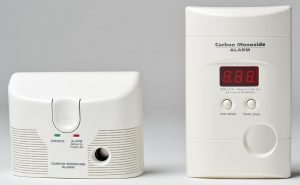
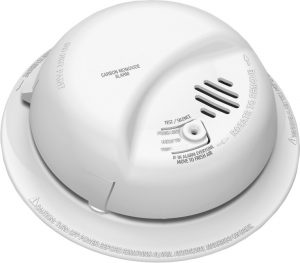
Yes. An alarm that detects both smoke and carbon monoxide (CO) is called a COMBINATION ALARM.
This is not the same thing as as a “dual sensor” alarm. A dual sensor smoke alarm uses two kinds of smoke-detecting technologies in case of fire; it does not detect CO.
Carbon monoxide is known as the “invisible killer.” Known as CO, this poisonous gas is odorless and colorless. You can’t smell or see it. Each year in the U.S., unintentional CO poisoning kills over 400 people and sends more than 20,000 to the emergency room.
You must have CO alarms at home if you have any gas appliances, such as a gas-powered stove, oven, furnace, water heater, or fireplace. We also recommend you have CO alarms if you have any type of fireplace (even wood-burning), an attached garage, or a heated hot tub / pool.
 For more information, please read our printable Get to Know CO leaflet here.
For more information, please read our printable Get to Know CO leaflet here.
Alarms with traditional (alkaline) batteries are fine. But those batteries must be changed at least once a year—and you may experience a “chirping” sound when the batteries are dying, which will require your immediate attention for safety.
Instead, we recommend you get alarms that have long-life lithium ion batteries. Many alarms now come with these batteries sealed inside them; the packaging may read “Always On” or “Worry Free” or “Hassle Free.” This type of battery is designed to last 10 years, which is the average lifespan of a smoke alarm. (You can also get 9V lithium ion batteries to upgrade your existing alarms.) With lithium ion batteries, you won’t have to change the battery every year, and you won’t hear “dying battery chirps” as often. But you WILL still have to push the test buttons on your alarms every month!
NOTE: If your alarm came with a lithium ion battery sealed inside and the alarm starts to chirp, replace the ENTIRE alarm right away!
We recommend purchasing a major brand from an established hardware or home supply source. Make sure you get alarms with the label of a recognized testing laboratory. Save and always follow the manufacturer’s instructions.
A smoke alarm with a PHOTOELECTRIC sensor is better at detecting slow, smoldering fires, while a smoke alarm with an IONIZATION sensor is better at detecting fast-flaming fires. An alarm with both types of sensors is called a DUAL SENSOR alarm. We recommend your home has at least one of each kind (ionization vs. photoelectric), and get as many dual sensor alarms as you can. The National Fire Protection Association (NFPA) has more useful information on these alarm types.
Also, if you have any gas appliances, you should have at least one carbon monoxide alarm on every level of your home. You may choose to get a COMBINATION alarm that can detect both smoke and carbon monoxide.
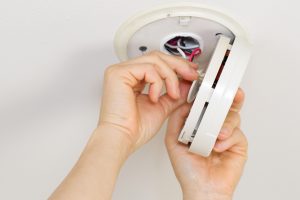
The best protection comes from alarms that are HARD-WIRED (also known as INTERCONNECTED), meaning they are tied into your electricity with a battery back-up. When one hard-wired alarm sounds in your home, they all sound! Most homes built since the 1990s have hard-wired alarms.
“Don’t Wait to Check the Date!” If you’re not sure how old your alarms are, twist and carefully pull the alarm off the wall/ceiling, turn it over to see the back, and look for a small stamp or sticker that shows a month and year. This is when the alarm was made, also known as the “manufacture date.”
NOTE: If you move into a home that was built over 10 years ago, you should look on the back of all alarms to find out when they were made, or verify that the inspector specifically checked for this.
If your alarms are hard-wired into your home’s electricity, be sure to first turn off power before removing or replacing an alarm.


SMOKE ALARMS should be replaced at least every 10 years. The sensors on smoke alarms are generally not designed to be reliable or effective after about 10 years. This is true both for hard-wired (interconnected) alarms and independent (single-station) alarms.
On the other hand, CARBON MONOXIDE (CO) ALARMS are only designed to work reliably for 5 to 7 years, which is shorter than the lifespan of a smoke alarm. So if you buy a combo smoke/CO alarm, follow the manufacturer’s instructions and replace it within 5 to 7 years.
Immediately replace any alarm (smoke or CO) that fails a push-button test after getting fresh batteries, or if it makes “end of life” chirps.
Unless your alarm came with 10-year lithium ion batteries sealed inside, you will need to replace standard (alkaline) batteries at least once a year. We recommend changing the batteries in all your alarms at the same time. (If your alarm starts chirping, immediately change the batteries! Then hold down the test button for a few seconds to see if you hear a long beep as you should.) One way to remember to do this is to time the battery change around your birthday. You may choose to go a step further by changing them every six months; you can remember this around Daylight Savings Time: “CHANGE YOUR CLOCKS, CHANGE YOUR BATTERIES!”
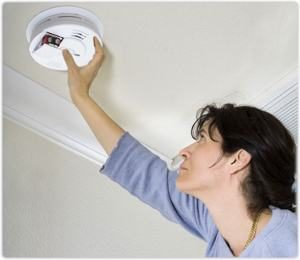
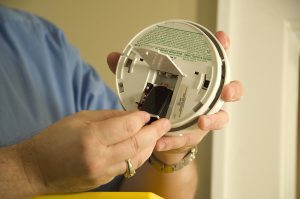
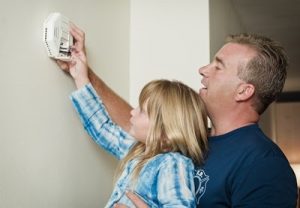
Both smoke alarms and carbon monoxide alarms should be tested at least once a month! This is true even for hard-wired/interconnected alarms, since the alarm itself can fail despite it still having battery or electrical power. Push the test button for a few seconds until it beeps loudly to indicate that the alarm is working. (If you can’t safely use a ladder, you may be able to do this by using a pencil, broom handle or wooden spoon to reach up to the alarm.) Conduct this test on each and every alarm, every month.
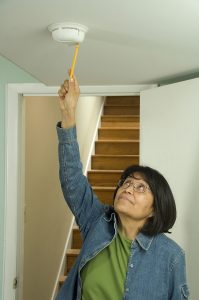
We recommend making this a family activity, which will encourage everyone to stay familiar with the sound of the alarm and what actions to take when you hear it as part of your “home escape plan.” Follow the manufacturer’s instructions for your alarms.
If an alarm does not make a long, loud beep when you hold down the push button for several seconds, typically your first step in “trouble-shooting” will be to replace the battery then conduct the same test again. If your alarm still fails the push-button test after installing a fresh battery, double-check that the smoke alarm is not more than 10 years old … and the CO alarm is not more than 5-7 years old. (The date of manufacture should be displayed on a small stamp or sticker on the back of the alarm; smoke alarms are designed to be replaced at least every 10 years, and CO alarms are designed to be replaced every 5 to 7 years.) If you believe your alarm has exceeded its reliable lifespan, your next step in trouble-shooting would typically be to replace the actual alarm, and consider doing so for ALL alarms in your home simultaneously so they are all the same age. However, if you believe an power outage or other problem with your electrical supply may have tripped up your hard-wired alarms, consider resetting the breakers and/or calling a certified electrician for assistance.
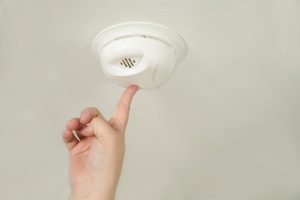
Remember that smoke rises! Install the smoke alarm high on the wall or ceiling, at least 4 inches but no more than 12 inches away from the ceiling; this is illustrated in our printable Smoke Alarms brochure. To minimize false alarms, we recommend against putting smoke alarms in kitchens, garages and bathrooms. Smoke alarms should be installed at least 10 to 20 feet from a cooking appliance. Also, don’t install alarms near windows, doors or ducts where drafts might interfere with their operation. If you have pitched ceilings, install the alarm within 3 feet of the peak but not within the apex of the peak (at least 4 inches down from the peak).
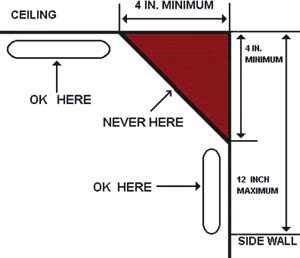
This depends on the size and layout of your home. At a minimum, install smoke alarms:
Additionally, you need carbon monoxide alarms if your home has any gas appliances. (We also recommend installing CO alarms if you have an attached garage or any type of fireplace–even wood-burning.) However, it usually sufficient to have one CO alarm on each level of the home.
